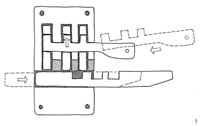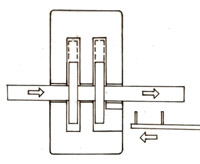Wooden locks
As stated earlier, the earliest locks in China were the wooden beams on the inside of gates, which are more or less as old a concept as the gates themselves. In combination with metal locks, gate beams have been used even into modern day. In some cases, the beams could be maneuvered from the outside with a simple “key” of wood or bronze.
Another example of early wooden locks in China are pin tumbler locks. They were based on the wooden pin tumbler locks used in ancient Egypt over 3,000 years ago. Due to the circumstances in which they were discovered, these are called Egyptian locks, although there is significant evidence that the Egyptians adopted this type of lock from earlier cultures in Mesopotamia. Pin tumbler locks were common in many cultures; they were used in Greece 2,000 years ago and gradually spread to large parts of Europe, Asia and Africa.
 |
 |
Swedish wooden pin tumbler lock with wooden key and bolt. Sketch by the author
|
Chinese wooden pin tumbler lock with wooden key and bolt. Reliefs on the front. Sketch by the author |
Swedish pin tumbler locks consisted of a square piece of hard beech or birch wood with channels for two, three or four pin tumblers, a bolt and key. They were inexpensive and easy to replace when they broke. The wooden pin tumblers held the moving bolt in place, and the key was made of the same material and had the same number of teeth as the lock had pin tumblers. To open the lock, the key was inserted in the side of the lock body and lifted the pins hidden inside so that the bolt could be drawn. The Chinese pin tumbler lock (see figure above) worked in the same way.
Padlocks
Older and antique Chinese padlocks I have come into contact with use shackles fitted with ward springs. They are maneuvered with a key inserted into one of the short sides of the lock, whose bit compresses the spring to release the shackle so that it can be pulled out. Two springs is the norm, but there are locks with three, four, five or six springs.
Another common lock design is the keyless warded lock (combination lock). Padlocks with a threaded screw mechanism were also used in China.